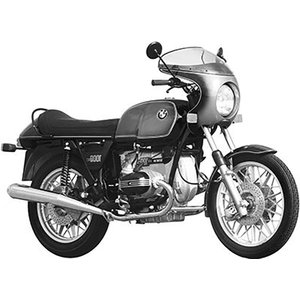The Timeless Appeal of the BMW R 100 S (1976–1979): A Retrospective Review
Introduction: A Legend of Its Era
The late 1970s were a golden age for motorcycling, and the BMW R 100 S stands as a defining machine of this period. As BMW’s sportier iteration of their iconic boxer-twin lineup, the R 100 S bridged the gap between touring comfort and spirited riding—a balance that still resonates with riders today. With its distinctive styling, robust engineering, and a reputation for reliability, this motorcycle remains a sought-after classic. Let’s explore why the R 100 S continues to captivate enthusiasts decades after its production.
Design: Form Meets Functionality
The R 100 S’s design is quintessentially BMW: purposeful, elegant, and slightly rebellious. The signature horizontally opposed "boxer" engine juts out proudly, giving the bike a muscular stance. The 810 mm (31.9-inch) seat height accommodates most riders comfortably, though taller riders might find the ergonomics slightly compact. The chrome-accented fuel tank, twin analog gauges, and rounded headlight scream 1970s charm, while the sculpted dual seats hint at its touring capabilities.
BMW’s attention to durability shines through in details like the corrosion-resistant finishes and the robust shaft drive system. The 225 kg (496 lb) weight is noticeable at a standstill, but the low center of gravity from the boxer engine makes it surprisingly manageable once moving.
Engine and Performance: The Heart of the Beast
At the core of the R 100 S lies its 980 cc air-cooled boxer twin, producing 65 PS (48 kW). While these figures seem modest by today’s standards, the engine’s character is anything but. Throttle response is immediate, with a linear power delivery that builds smoothly from 3,000 RPM. The torque-rich design excels in real-world riding, pulling strongly from low revs—ideal for overtaking or climbing hills without constant gear changes.
The engine’s air-cooling system contributes to its reliability, though it does generate noticeable heat in traffic. The exhaust note is a deep, throaty rumble that becomes addictive on open roads. Cruising at 120 km/h (75 mph) feels effortless, with vibrations kept in check by BMW’s meticulous balancing.
Handling and Ride Experience: A Dance of Precision
The R 100 S’s handling defies its weight. The 36 mm telescopic forks and twin shock absorbers provide a plush yet controlled ride, absorbing bumps without wallowing. Tire pressures—1.9 BAR (27.5 PSI) front and 1.8 BAR (26 PSI) rear under normal load—strike a balance between grip and comfort.
The shaft drive eliminates chain maintenance hassles and delivers buttery-smooth acceleration. Corners are tackled with confidence thanks to the boxer engine’s mass-centralized layout, though the narrow handlebars require deliberate input. Braking, handled by single discs up front and a drum rear, is adequate for the era but demands anticipation by modern standards.
On winding roads, the R 100 S feels alive—a machine that rewards skill without punishing minor mistakes. The upright riding position reduces fatigue on long rides, though wind protection is minimal.
Competition: How It Stacks Up
The late-1970s motorcycle market was fiercely competitive. Here’s how the R 100 S compared to its rivals:
- Honda CB750K: The CB750’s inline-four engine was smoother and more powerful (68 PS), but its chain drive required frequent maintenance. The Honda felt more “modern” but lacked the BMW’s long-distance refinement.
- Moto Guzzi Le Mans 850: Another shaft-driven rival, the Le Mans offered sharper handling and a racier stance. However, its vibey V-twin couldn’t match the BMW’s low-end torque.
- Kawasaki Z1-R: A brute with 90 PS, the Z1-R dominated straight-line speed but felt unwieldy in corners. The BMW’s build quality and reliability were superior.
The R 100 S carved its niche as a sport-tourer—less aggressive than pure sport bikes but more engaging than touring-focused models. Its shaft drive and build quality made it a favorite for riders prioritizing longevity over outright speed.
Maintenance: Keeping the Legend Alive
Owning a classic like the R 100 S requires diligence, but its mechanical simplicity makes it a rewarding project. Here are key maintenance considerations:
- Valve Adjustments: Intake valves need 0.10 mm clearance, exhaust valves 0.20 mm (cold). Check every 5,000 km (3,100 miles).
- Oil Changes: Use SAE 20W-50 (2.25 L with filter). The air-cooled engine thrives on regular oil changes—every 3,000 km (1,864 miles) is ideal.
- Suspension Fluid: The telescopic forks hold 250 mL of SAE 5W/10W oil. Refresh every two years to maintain damping performance.
- Spark Plugs: NGK BP7ES (standard) or BPR7EIX (iridium) with a 0.6 mm gap. Iridium plugs offer longer life and better ignition.
- Shaft Drive: Replace final drive oil (250 mL SAE 90 GL-5) annually. Inspect seals for leaks.
At MOTOPARTS.store, we stock period-correct parts and upgrades—from NGK spark plugs to high-performance brake pads that improve stopping power. Consider upgrading to synthetic oils for better heat management.
Conclusion: A Machine That Stands the Test of Time
The BMW R 100 S isn’t just a motorcycle; it’s a testament to an era when engineering honesty and rider connection mattered above all. Its blend of torquey performance, timeless design, and mechanical simplicity ensures it remains relevant in a world dominated by electronics and disposable parts. For riders seeking a classic that can still handle daily duties or weekend adventures, the R 100 S is a compelling choice.
Whether you’re restoring one or maintaining a well-loved example, MOTOPARTS.store has the expertise and components to keep your BMW running flawlessly. After all, legends deserve nothing less.



















